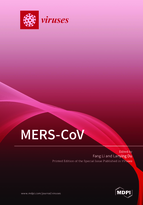MERS-CoV
A special issue of Viruses (ISSN 1999-4915). This special issue belongs to the section "Human Virology and Viral Diseases".
Deadline for manuscript submissions: closed (30 November 2018) | Viewed by 200817
Special Issue Editors
Interests: coronavirus entry; X-ray crystallography; cryo-electron microscopy; structure-based vaccine design
Special Issue Information
Dear Colleagues,
Middle East Respiratory Syndrome Coronavirus (MERS-CoV) is a newly emerged coronavirus: It was identified in 2012 and has, so far, caused over 2100 infections and a ~35% fatality rate in humans. Similar to the SARS coronavirus, MERS-CoV is a zoonotic virus: it likely originated from bats, since numerous MERS-like coronaviruses have been isolated from bats. Camels may also have contributed to the zoonotic transmission of MERS-CoV. People infected with MERS-CoV often develop severe acute respiratory illness, including fever, cough, and shortness of breath. Viral accessory proteins potentially contribute to the pathology of MERS-CoV by interfering with the innate immune response. Animal models, such as non-human primates and humanized mice, have been developed for the purpose of studying MERS-CoV infections. MERS-CoV enters cells by binding to its host receptor, dipeptidyl peptidase 4, and fusing viral and host membranes, before it replicates itself inside cells. Recent advances in structural biology have enhanced our understanding of the viral entry and replication processes. Vaccines and therapeutics against MERS-CoV are being developed, although none are yet clinically available. With the continual threat of MERS-CoV, there is a great need to summarize current progress and discuss the future prospects of MERS-CoV research.
In this Special Issue, we welcome the MERS-CoV community to submit research papers or review articles on recent advances of MERS-CoV research. Topics may include, but are not limited to, MERS-CoV epidemiology, zoonosis, pathogenesis, immune responses, animal models, viral entry and replication, virus structures, vaccine development, and therapeutic targeting.
Dr. Fang LiDr. Lanying Du
Guest Editors
Manuscript Submission Information
Manuscripts should be submitted online at www.mdpi.com by registering and logging in to this website. Once you are registered, click here to go to the submission form. Manuscripts can be submitted until the deadline. All submissions that pass pre-check are peer-reviewed. Accepted papers will be published continuously in the journal (as soon as accepted) and will be listed together on the special issue website. Research articles, review articles as well as short communications are invited. For planned papers, a title and short abstract (about 100 words) can be sent to the Editorial Office for announcement on this website.
Submitted manuscripts should not have been published previously, nor be under consideration for publication elsewhere (except conference proceedings papers). All manuscripts are thoroughly refereed through a single-blind peer-review process. A guide for authors and other relevant information for submission of manuscripts is available on the Instructions for Authors page. Viruses is an international peer-reviewed open access monthly journal published by MDPI.
Please visit the Instructions for Authors page before submitting a manuscript. The Article Processing Charge (APC) for publication in this open access journal is 2600 CHF (Swiss Francs). Submitted papers should be well formatted and use good English. Authors may use MDPI's English editing service prior to publication or during author revisions.
Keywords
- MERS-CoV
- epidemiology
- animal origins
- pathogenesis
- immune responses
- animal models
- entry and replication
- virus structures
- vaccines and therapeutics
Related Special Issue
- Coronaviruses in Viruses (97 articles)







